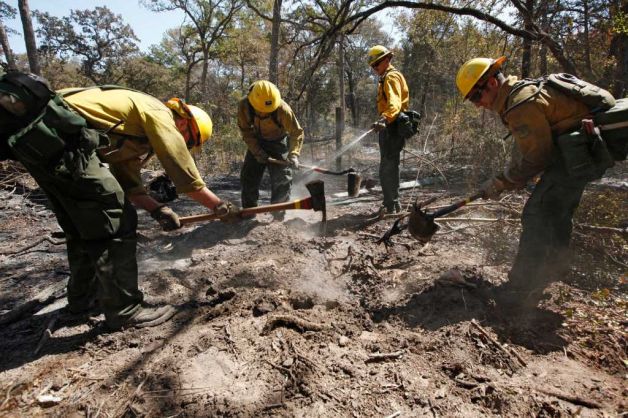
The American Red Cross has time-tested tips to help people affected by the wildfires across Bastrop, Travis, and Williamson counties speed their recovery after this disaster.
Regional CEO Marty McKellips says, “returning to your home after the devastation of a wildfire is a stressful time fraught with real dangers. There are important steps each family should take to assure their continued safety and the Red Cross wants to get this information to our community.”

Returning to Your Neighborhood
Don’t return home until fire officials say it is safe – Wildfires can be unpredictable so it’s best to listen to the experts.
Use caution and exercise good judgment when entering burned areas – Hazards may still exist, including hot spots, which can flare up without warning.
Avoid damaged or fallen power poles or wires – Immediately report electrical damage to authorities. Electric wires can deliver shocks or ignite new fires. If possible, remain on the scene to warn others of the hazard until repair crews arrive.
Be careful around burned trees and power poles – Theymay have become unstable because of fire damage or loss of support from surrounding trees.
Watch for ash pits and mark them for safety – Ash pits are holes full of hot ashes, created where intense fire has burned trees or stumps deep into the ground. People or animals can be seriously burned by falling into ash pits. Warn family and neighbors to keep clear of the pits. Erect a barrier with nonflammable materials such as wire mesh fencing or otherwise clearly mark such areas.
Returning to Your Home
Inspect roofs immediately and extinguish any sparks or embers – Windsmay have deposited burning embers that could reignite.
If there is no power, check to make sure the main breaker is on – Firesmay cause breakers to trip. If the breakers are on and power is still not present, contact your utility company.
For several hours afterward, recheck for smoke and sparks outside and inside the home, including the attic – Thewinds of wildfires can blow burning embers anywhere. Keep checking your home for embers that could cause new fires.
Take precautions while cleaning your property as you can be exposed to potential health risks from new hazards.
Wet down debris to minimize health impacts from breathing dust particles
Use a two-strap dust particulate mask with nose clip and coveralls for the best minimal protection
Wear leather gloves to protect hands from sharp objects while removing debris
Wear rubber gloves when working with outhouse remnants, plumbing fixtures and sewer piping as they can contain high levels of bacteria
Hazardous materials such as kitchen and bathroom cleaning products, paint, batteries, contaminated fuel and damaged fuel containers need to be handled properly to avoid risk; local authorities can provide hazardous disposal assistance
If you have a propane tank system, turn off valves and leave them closed until a propane supplier inspects the system – Heatcan damage tanks, brass and copper fittings, and lines, leaving them unsafe. If fire heated the tank, the pressure relief valve probably opened and released the contents.
If you have a fuel oil tank system, contact your supplier for an inspection of the system before use – Thetank may have shifted or fallen from its stand and fuel lines may have kinked or weakened. Heat from the fire may have caused the tank to warp or bulge. Non-vented tanks are more likely to bulge or show signs of stress. The fire may have loosened or damaged fittings and filters.
Check your trees for stability – Any tree that has been weakened by fire may be a hazard. Winds topple weakened trees and the loss of trees can change wind patterns in your area.
Look for burns on the tree trunk. If the bark of a trunk has been burned off or scorched completely around the circumference, that tree is unlikely to survive. Where fire has burned deep into the trunk, the tree should be considered unstable.
Check for burned roots by probing the ground around the base of the tree and several feet away from the base with a rod. Roots are generally six to eight inches below the surface. If the roots have been burned, you should consider this tree very unstable and subject to being toppled by the wind.
A scorched tree is one that has lost part or all of its leaves or needles. Healthy deciduous (broadleaf) trees are resilient and may produce new branches and leaves as well as sprouts at the base of the trunk. Evergreen (needled) trees may survive when partially scorched. An evergreen tree that has been damaged by fire is subject to bark beetle attack. Seek assistance from the forestry service or a professional for ways to protect evergreens from insect attack.
Central Texans who wish to make a financial contribution to the American Red Cross of Central Texas can call 800 or 512-928-4271, send a financial contribution to 2218 Pershing Drive, Austin, 78723 or make a secure online donation at www.centex.redcross.org. For information on Red Cross services or volunteer opportunities please call 800 or 512-928-4271 or visit www.centex.redcross.org.
About the American Red Cross:
The American Red Cross shelters, feeds and provides emotional support to victims of disasters; supplies nearly half of the nation’s blood; teaches lifesaving skills; provides international humanitarian aid; and supports military members and their families. The Red Cross is a charitable organization — not a government agency — and depends on volunteers and the generosity of the American public to perform its mission. For more information, please visit www.redcross.org or join our blog at http://blog.redcross.org.
Source: www. centex.redcross.org
[youtube pqr2DNaMLiQ]